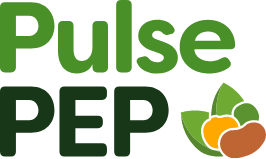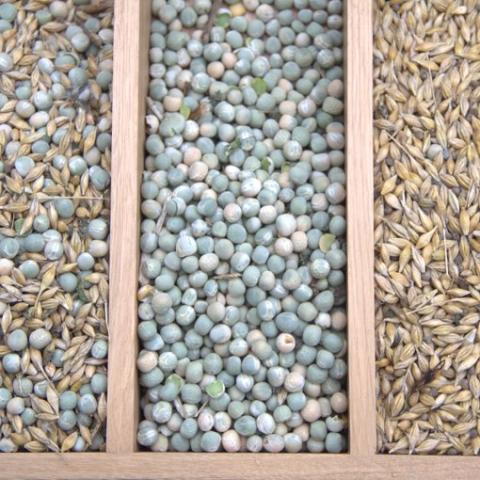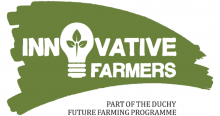To help address some of these concerns, we spoke with Senior Farming Advisor Jerry Alford, who coordinates the UK field lab on cereal/legume intercropping as part of the Horizon Europe LEGUMINOSE project. The aim of LEGUMINOSE is to break down barriers to intercropping, making it a mainstream farming practice.
Can intercropping improve soil health?
Yes, intercropping can boost soil structure and increase levels of nutrients like nitrogen, phosphate, and potash. Essentially, you’re growing two crops together and improving the soil at the same time. It’s one of the main benefits we’re focusing on in the LEGUMINOSE project.
How should I choose crops for intercropping?
Choose species that will grow well together, ideally ones that are planted and harvested around the same time. Compatibility is important. For example, peas harvest is easier when grown with oats because the oats give them something to climb on. Be prepared for differences in crops, and it’s especially important to pick varieties with similar harvest dates. Farmers are still learning the best crop combinations and timing for successful intercropping.
How does intercropping affect disease and pest levels?
The diversity in the field makes it harder for pests and disease to spread quickly. Different crops are susceptible to different pests and diseases, so mixed crops provide each other with protection. We also think that healthier soil – often the result of intercropping – makes the plant more resilient. While much of the evidence is anecdotal, many farmers say they deal with fewer pest and disease problems when they intercrop.
Does intercropping reduce the need for fertiliser?
This is an area we’re looking at in the project. Legumes can fix their own nitrogen, meaning they don’t need artificial fertilisers. The expectation when you’re growing legumes with cereals is that the legume will be feeding or supporting the cereal some extent. But there’s some work exploring whether applying low levels of fertiliser early in the season might still be beneficial. There are indications that wheat in wheat-bean intercrops may have higher protein content due to late-season nitrogen. The timing and quantity of fertilisation are also being researched.
What are the options for harvesting intercrops?
Typically, intercrops are harvested together as a combined crop. This means you choose two species that ripen at the same time and run them through the combine together. The challenge is managing different types of crops, like small grains and larger beans, which need careful setup for the combine. It can be tricky, but it’s definitely doable.
Some farmers are trying out new methods, like harvesting different crops separately from the same field. For instance, while this isn’t common in the UK just yet, there is an American farmer growing soybeans and barley together, harvesting the barley in the summer and then the soybeans a month later. Generally, in the UK, farmers are harvesting both crops at the same time. After that, you can sell the crops separately or as a combined product, which is especially handy for the animal feed market.
Do you need to separate intercrops post-harvest?
The ability to separate does provide marketing opportunities, although livestock producers will be able to utilise the mixed product. Crop separation is an additional operation and is dependent on the two crops being different sizes, although machines separating based on colour do already exist on the market. Existing on-farm cleaners can be used but may require a little adaptation to separate the two crops as well as dust, trash and weed seeds to reach market specification, particularly for human consumption markets.
Does intercropping improve overall yield?
While we’re still waiting for the final trial results, intercropping usually gives a higher total yield per unit area compared to growing single crops. Farmers often get 1.2 to 1.3 times more yield per hectare when they combine the output of both crops, although the yield of each individual crop might not increase.
Is there a market for intercrop products?
Yes, there is a growing market for intercrop products. Farmers can sell crops separately into a market or as a combined product, which is appealing to feed mills. These mills can process combined products without needing to separate them, making it a cost-effective option. For example, a mix of high-protein wheat and beans can be directly integrated into feed rations.
Where can I find advice if I’m considering intercropping?
There are plenty of great resources out there. The Soil Association has useful guides, and the Innovative Farmers website has some great insights into intercropping. Andy Howard’s Nuffield Scholarship on intercropping is also a fantastic resource. While intercropping isn’t a new technique, it's getting a lot of renewed attention as we explore ways to adapt to current agricultural challenges.
Interested in innovating with intercrops? There are currently 12 farmers in the UK involved in intercropping trials, and Jerry welcomes more to join. If you have an idea you’d like to test, such as winter intercrops or growing in strips, get in touch at jalford@soilassociation.org. Learn more about the intercropping field lab.
This trial is part of the LEGUMINOSE project which is funded by Horizon Europe with UK funding provided by UKRI. For more information see www.leguminose.eu. Views and opinions expressed are however those of the author(s) only and do not necessarily reflect those of the European Union or European Commission. Neither the European Union nor the granting authority can be held responsible for them.
This article is from innovative farmers




